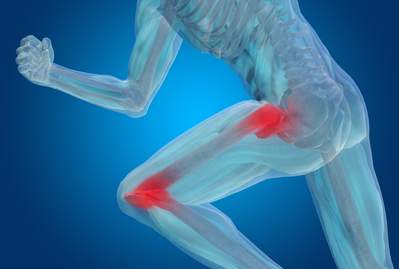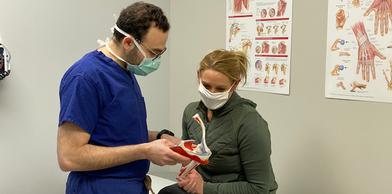Not long ago, I read an article about the elective surgeries that have had the greatest impact on patients’ daily lives. The second most common response (behind cataract surgery), was hip replacement surgery. Even though as an orthopedic surgeon I perform hip replacement surgeries all the time, I’m still amazed at how quickly the surgery can make a profound impact on someone’s day-to-day life.
Helping patients get back to doing the things they love is what I like most about my work as an orthopedic surgeon specializing in hip and knee replacements. Arthritis in their hip or knee is making it hard and painful for people to walk, and I can help fix that problem and get them back on their feet again. When I get to see the positive impact we have on someone’s life, there’s nothing better than that.

Jonathan Ben-Zev, M.D. Orthopedic Surgeon - Hip and Knee Specialist
The power of replacement
During my residency, I played hockey in an adult league. I found out that one of the older guys on our team – a really excellent skater and hockey player – was playing with a replaced hip joint. It really resonated with me that the type of surgery I perform was able to help him play hockey late into life – something I hope to do myself.
Joint replacement is never something you need to do. As a mentor once told me, in the history of the world, no one has ever died of arthritis, so I never use the word need. If a patient is a candidate for surgery, I would tell them that I think they would benefit from a hip or knee replacement, but it’s always their call.
When I see a patient with arthritis for the first time, I show them pictures of a healthy joint and an arthritic one, and then the x-rays of their joint – so they get some context on where they fall on the spectrum. But I remind people that the x-rays only show me what their joints look like. I rely on the patient to tell me how they feel.
When I ask how much their joint pain bothers them, some patients admit they have pain, but not enough to make them want to have surgery. Others tell me the pain is affecting their quality of life, they can’t sleep at night, or do things they want to do, and they’re ready for surgery. I also try to be very clear with patients – whether we're talking about joint surgery or just a steroid shot – that they don't have to decide today, and can always change their mind later.
Surgical technique
During my medical training, I learned to do what are called press-fit knee replacements. These are designed to have the bone in the knee attach and bond to the metal replacement joint – as opposed to a traditional cemented knee replacement in which quick-drying cement is used to fix the new joint in place.
Cemented knee replacements account for the majority of knee surgeries done around the world, and can be the right choice for a patient who has softer bone due to osteoporosis. One thing to consider with cement though, is that if the cement ever cracks – due to a fall or an injury, for example – the cement could lose its ability to keep the implant in place. On the other hand, if there is ever a broken bone with a press-fit knee replacement, it may not require another surgery.
Hip replacements can be different. Most surgeons – including me – use a press-fit stem. But if I see an older patient in the emergency department with a broken hip, I’m more likely to perform a cemented joint replacement, just because they’re more likely to have lower bone quality – meaning less bone density, osteoporosis.
Going home the same day
Most of my hip and knee replacement patients go home the same day of their surgery. I strongly believe that people do better recovering at home and getting to sleep in their own bed than staying in the hospital. This requires more planning and preparation before surgery, but I think it is worth the extra work. If a patient has more complicated medical issues in addition to needing a hip or knee replaced, then they usually spend a night or two in the hospital after surgery.
A different approach to hip replacement
During my training, I also learned how to perform a total hip replacement using what’s called an anterior, or from the front, approach, which results in a faster and easier recovery than the traditional posterior, or from the back, approach. Posterior surgery requires a large incision in the muscles on the buttocks, which then also have to heal after the hip surgery, causing the patient more pain and a longer recovery time. But with the anterior approach, I make an incision in the front of the patient’s hip and access their joint by working around and through the muscles. This can result in less post-operative pain, and typically enables patients to walk and go up and down stairs without assistance much faster. which speeds their recovery.
In addition, I try to do as many joint replacement surgeries as possible without general anesthesia, opting for spinal anesthesia and sedation whenever I can. This also helps patients recover faster.
Dancing with the grandchildren
Seeing patients do well after their surgeries is my favorite part of my job. I recently saw a patient and his wife three months after his total hip replacement. He is so happy and feels so much better. His wife said their kids noticed how different he is, dancing with his grandkids at Christmas. Another patient asked me if he would be able to walk his dog after his knee replacement. I told him he’d be walking his dog better than he has in the last ten years.
I love working with the team we have here at Froedtert South who help make our surgeries successful – the nurses, medical assistants, and our physicians’ assistants. It’s such a privilege for all of us to be in a position to help so many people get their lives back.
Hip and Knee Replacements by the Numbers
According to the American College of Rheumatology:
- Approximately 790,000 total knee replacements and 450,000 hip replacements are performed in the U.S. every year
- As our population ages, those numbers continue to grow
- Total joint replacement is one of the safest and most reliable treatments in any area of medicine
- A hip or knee replacement performed today can be expected to last for twenty or more years
- For most patients, total joint replacement will be a lifelong solution for the arthritis in their knees or hips


